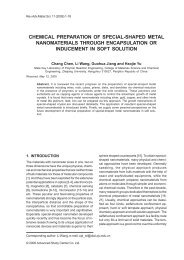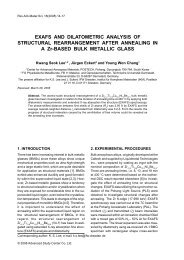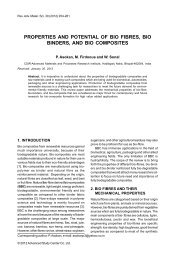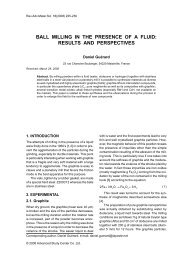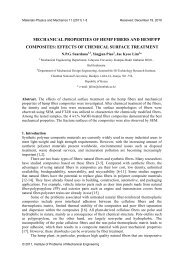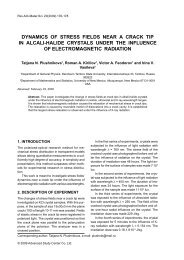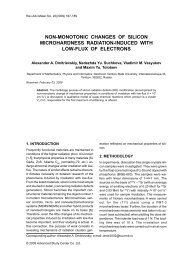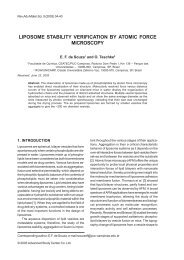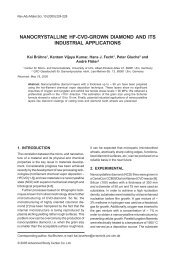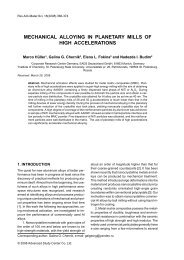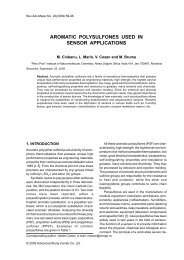surface pretreatment by phosphate conversion coatings – a review
surface pretreatment by phosphate conversion coatings – a review
surface pretreatment by phosphate conversion coatings – a review
Create successful ePaper yourself
Turn your PDF publications into a flip-book with our unique Google optimized e-Paper software.
156 T.S.N. Sankara Narayanan<br />
Fig. 9. DSC curves of unmodified zinc <strong>phosphate</strong><br />
coating (a) before stoving; and (b) after stoving and<br />
rehydrated at 100%RH for 63 hours. (Source: R.A.<br />
Choudhery and C.J. Vance in Advances in Corrosion<br />
Protection <strong>by</strong> Organic Coatings, D. Scantelbury<br />
and M. Kendig (Eds.), The Electrochemical Society,<br />
NJ, 1989, p.64. Reproduced <strong>by</strong> permission of<br />
The Electrochemical Society, Inc.).<br />
to similar conditions (Fig. 10) [313]. The main limitation<br />
of DSC is that the <strong>phosphate</strong> coating has to<br />
be physically removed from the substrate.<br />
Handke has demonstrated the use of FTIR to<br />
study the mechanism of <strong>phosphate</strong> coating formation<br />
[327]. FTIR is sufficiently sensitive to distinguish<br />
between different types of <strong>coatings</strong> in terms<br />
of composition and crystallinity [313]. FTIR is also<br />
sensitive to the degree of hydration of <strong>phosphate</strong><br />
<strong>coatings</strong>. The FTIR spectra of nickel and manganese<br />
modified zinc <strong>phosphate</strong> coating on cold rolled<br />
steel (CRS) and zinc coated steel (ZCS) under conditions<br />
namely, before heating, after stoving at 180<br />
°C for 20 minutes and after exposure to 100% RH<br />
for 14 days was analyzed (Figs. 11 and 12). The<br />
assignments of the FTIR spectra for CRS and ZCS<br />
Fig. 10. DSC curves for nickel and manganese<br />
modified zinc <strong>phosphate</strong> coating. Solid line represents<br />
before stoving and broken line represents after<br />
stoving and subsequent rehydration. (Source:<br />
R.A. Choudhery and C.J. Vance in Advances in<br />
Corrosion Protection <strong>by</strong> Organic Coatings, D.<br />
Scantelbury and M. Kendig (Eds.), The Electrochemical<br />
Society, NJ, 1989, p.64. Reproduced <strong>by</strong><br />
permission of The Electrochemical Society, Inc.).<br />
are given in Tables 8 and 9, respectively. The FTIR<br />
spectra of <strong>phosphate</strong> <strong>coatings</strong> on CRS and ZCS<br />
are similar before heating. On heating there are significant<br />
changes in the FTIR spectra of ZCS while<br />
the changes for steel are less noticeable. On exposing<br />
to 100% RH it is evident that <strong>phosphate</strong> <strong>coatings</strong><br />
formed on ZCS shows greater tendency to rehydrate,<br />
indicated <strong>by</strong> the increase in intensity of all<br />
peaks associated with water vibrations. On the other<br />
hand <strong>phosphate</strong> coating formed on CRS exhibit very<br />
little tendency to rehydrate; the spectrum essentially<br />
remains constant.<br />
The infrared and Raman spectra of α-hopeite and<br />
phosphophyllite are shown in Figs. 13-15 [341]. They<br />
resemble the room temperature spectra reported <strong>by</strong><br />
Hill and Jones [342] and Hill [343]. The infrared and<br />
Raman spectra of both compounds display a large<br />
number of bands. In addition, the infrared and Raman<br />
spectra of these compounds resemble each other<br />
very strongly. Hence distinction of the respective<br />
peaks in <strong>phosphate</strong> <strong>coatings</strong> is not easy. However,<br />
there are some peaks, which are different for these<br />
compounds, are useful in identifying these compounds.<br />
For example the Raman bands at 1150,<br />
1055 and 310 cm -1 are typical for α-hopeite whereas<br />
the Raman bands at 1135, 1070 and 118 cm -1 are<br />
useful for identifying phosphophyllite in <strong>phosphate</strong><br />
coating.



